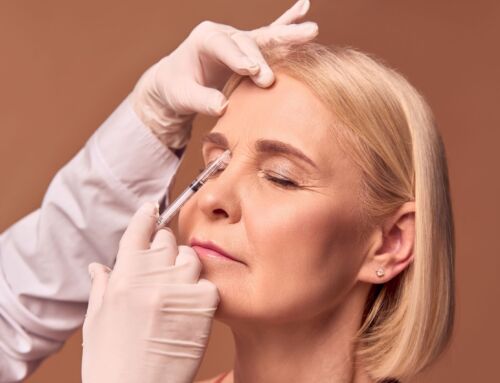 Imagine if you could tighten and lift your entire face, minimize wrinkles and eye bags, and even contour your face in less time than it takes to get a mani-pedi, not spend your entire savings doing so, and be able to return to work immediately after the procedure.
Imagine if you could tighten and lift your entire face, minimize wrinkles and eye bags, and even contour your face in less time than it takes to get a mani-pedi, not spend your entire savings doing so, and be able to return to work immediately after the procedure.
Sounds too good to be true, but it’s not!
You can get similar results to a facelift at a fraction of the cost with no surgery or downtime, thanks to a non-invasive aesthetic treatment called PDO threading.
PDO threading, or a thread lift, is commonly referred to as the ‘nonsurgical facelift’ due to its ability to lift and tighten the skin, similar to a facelift without surgery.
You are in and out the door in less than an hour, not under anesthesia, aren’t left with incisions or visible scarring, can resume normal activities almost immediately, and most patients say the entire procedure is relatively pain-free!
The skin tightening and lifting procedure has gained popularity in recent years with several A-listers like Eva Mendez, Simon Cowell and even royalty (Sarah Ferguson, the Duchess of York), all reportedly reaping the aesthetic benefits of having a non-invasive thread lift. But this rise in popularity has led to much misinformation about what PDO threads are, what they do, and if they are safe.
The confusion is partially because the nickname “thread lift” makes the procedure sound a little scary and invasive– which is one of the myths we will be busting. Other people are spreading misinformation because they are likely confusing the new FDA-approved dissolvable threads with thread lifts from decades ago that used permanent, non-absorbable threads and came with many complications that eventually led them to be pulled by the FDA.
Also keep in mind that not everything you see on social media shows the full story. Some content is designed to illicit a strong response from the viewers in order to boost engagement and views. If you have any concerns about the side effects of PDO threads, always consult a certified aesthetician.
In this article, we are busting PDO thread myths and telling you the truth about this one-of-a-kind procedure.
We will go over…
- What PDO threads are, and what benefits they provide.
- What a PDO thread lift is, how it is performed, and what to expect.
- Areas that PDO threads can treat.
- How do PDO threads compare to dermal fillers, and which is best.
- Combining PDO threads with other popular aesthetic treatments.
- The different types of PDO threads.
- How long PDO threads last.
- Plus some other common myths about PDO threads that simply aren’t true!
What Are PDO Threads?
PDO threads are a non-invasive way to tighten sagging skin, reduce wrinkling, and create new collagen. The PDO threads we use at Garza Surgery are classified as “collagen stimulators” (which we’ll explain a little further down), and are safe, FDA-approved and produced in the USA.
PDO stands for polydioxanone, a natural protein woven into a thin thread similar to human hair. Polydioxanone (PDO) threads are absorbable sutures made from the same material that dissolvable surgical sutures are made of.
Just like dissolvable surgical sutures, PDO threads are naturally absorbed into the body several months after they’re placed. There’s no follow-up thread removal needed. It’s a one-and-done treatment.
PDO threads are suitable for all skin colors and types, and while they are most commonly requested by those with aging skin, PDO Threads aren’t reserved for correcting the signs of advanced aging. Many viral beauty influencers in their 20s talk openly about how a thread lift helped lessen the appearance of eye bags and contour and tighten their face.
What Is A PDO Thread Lift?
The technology of a PDO thread lift allows a trained aesthetician to tighten sagging skin, improve skin laxity, and stimulate collagen and elastin production through the entire face and neck.
PDO threads treatment areas can include:
- Neck
- Jowls
- Jaw line – some also consider jawline filler
- Nasolabial folds
- Crow’s feet
- Under eye area
- Eyebrows
- Cheeks
- Marionette lines
To start the treatment, your skin is numbed, and the placement path of the threads are outlined to create the best lift for your areas of concern and unique facial tissues.
Next, the tiny hairlike threads are inserted through small punctures and placed into precise locations beneath the skin, where they stimulate collagen production as they tighten and lift the surrounding dermis and deeper tissue for complete facial rejuvenation. Don’t worry, these holes are tiny and don’t leave any visible marks or scars.
The procedure only lasts about 15 to 30 minutes, depending on the number of areas being treated, and you can resume most normal activities immediately.
A PDO thread lift is literally a “lunchtime lift” that can shave years off of your appearance, won’t set you back thousands and thousands of dollars sounds, and requires no surgery or downtime!
Now that we’ve covered the basics of PDO threads and what you can expect during a PDO thread lift, let’s dive into ten common myths about PDO threads that simply aren’t true!
Myth #1: PDO Threads Make You Look “Frozen”
Many anti-aging treatments can result in loss of movement in the face, especially if an injector overfills. That is NOT the case with PDO threads.
Threads are static, so they don’t stretch or stop the muscles in the face from reacting to how they naturally function. You won’t look plastic and can still raise your brows and smile without looking like a “joker.”
While on the topic of smiles, PDO threads are a much better option than dermal filler for treating marionette lines (the smile lines around your mouth.) If you want to learn more about treating marionette lines with PDO threads—click here.
When you have a PDO thread lift, you won’t look frozen. You can expect a naturally tightened, smoothed and rejuvenated face and neck.
Myth #2: PDO Threads Have The Same Results As Dermal Fillers
While both PDO threads and dermal fillers can make you look more youthful and refreshed, they are entirely different aesthetic treatments and offer different results.
Dermal fillers restore volume to treated areas of concern, provide mild lifting from sagging skin, and require regular touch-ups. Most patients return every 4-8 months for dermal filler maintenance.
The long-lasting benefit threads provide is why many patients prefer a thread lift over dermal filler. PDO threads address the whole face, provide more lift, tighten the skin and can last between 12 to 18 months. The next myth explains their expiration date a little more in-depth.
If you wonder which you should choose, you don’t have to pick one or the other. You can combine the two treatments, which we’ll discuss under myth #4.
But suppose you only want one treatment and are torn between the two? It really boils down to your personal skin concerns. But overall, we feel that PDO threads are typically a better option for most people that want a more defined face or are concerned with signs of aging.
A PDO thread lift can leave your entire face lifted and tightened and provides more long-lasting results compared to dermal fillers and other anti-aging treatments.
Myth #3: PDO Threads Don’t Provide Long Term Results
PDO threads do dissolve after about 6 months, but the effects don’t end once they have vanished. PDO threads can provide patients with great results for up to 18 months.
Because PDO threads stimulate collagen and elastin production and can contribute to skin hydration, you get long-term skin tissue rejuvenation.
Myth #4: PDO Threads Can’t Be Combined With Filler
You don’t have to choose one or the other! PDO threads and filler work great together. Many of our patients combine treatments and are thrilled with the results. In fact, you can achieve full facial rejuvenation by combining PDO threads and filler.
A thread will tighten and lift the whole face to create a more youthful appearance, while dermal filler provides wrinkle smoothing in targeted areas, contours the face, and adds volume to areas of concern such as the cheeks and lips.
When used together, dermal fillers and PDO threads can tackle all sorts of cosmetic concerns without needing a full surgical facelift.
Myth #5: PDO Threads Are Visible
Threads are surgical sutures made of a unique bioabsorbable substance that dissolves over time. They are inserted beneath the skin, so as long as they are inserted by a highly skilled and trained esthetician or surgeon, they cannot be seen or felt.
Note we said highly skilled and trained! The horror stories of visible threads and infection that you might stumble upon are likely because someone had their threads inserted by someone that was not qualified or highly skilled. Finding the right board-certified skin professional to carry out the procedure in a state-of-the-art clinic is crucial.
Here at Garza Surgery, our staff is skilled and trained in PDO threads and can perform the procedure perfectly, helping you safely create the youthful appearance you’ve always wanted without spending thousands of dollars or going under the knife.
Myth #6: PDO Threads Stretch The Skin
This is absolutely not true! PDO threads do not stretch the skin at all. There is no pulling of the top layer of the skin during a thread lift.
The threads are placed beneath the skin’s surface onto the fat layer and lift the dermis. Your skin then gently reacts to the sutures creating a “selective inflammatory response” that produces collagen and strengthens the skin.
Myth #7: PDO Threads Are Made Of Thread
PDO threads look and act like the type of thread you are likely picturing, but they aren’t actually thread; they are more like strings of sugar!
PDO threads are made of thermoplastic polyester derived from renewable resources like corn starch and sugar cane. PDO threads are one of the safest materials used in the body (the same material used in cardiac surgeries) and are re-absorbable and biocompatible.
There are two types of threads, barbed threads and smooth threads, which we will discuss in our next myth!
Myth #8: There Is Only One Type Of PDO Thread
There are actually several types of PDO threads, and each serves its own unique purpose. Your esthetician may use only one thread type or a combination of threads during your treatment.
The two most common PDO threads used are barbed threads and smooth threads.
Barbed Threads: Also known as lifting threads, barbed threads are the stronger of the two threads and are used to lift heavier tissue. Like smooth threads, they also stimulate collagen production.
Areas most commonly treated with barbed (lifting) threads are:
- Jaw lift
- Cheek lift
- Arte lift
- Eyebrow lift
- Neck lift
Smooth Threads: Much like barbed threads, smooth PDO threads also provide skin rejuvenation, skin tightening, and smooth skin texture and can promote collagen production. The only difference is they do not have the barbs needed to pull back.
Areas and concerns most commonly treated with smooth threads are:
- Acne scars
- Eyebrow commas
- Glabellar lines/forehead wrinkles
- Marionette lines/chin lines
- Radial lip lines
- Skin tightening
- Submental tightening
- Vermillion border
Both barbed (lifting) threads and smooth threads are dissolvable, so no follow-up appointment is required and provide results for 12-18 months.
Myth #9: PDO Threads Are Invasive and Painful
We know it sounds scary and painful to think about threads being placed beneath your skin, but honestly, most of our patients say they barely feel anything at all during the procedure.
A numbing agent is used before inserting the threads and throughout the process. You shouldn’t feel much more than slight pinches of discomfort. On a pain scale of 1 to 10, most patients say they never feel anything above level 5.
While a thread lift is a little more uncomfortable than injectable aesthetic treatments like Botox and dermal filler, the overall threading procedure is relatively pain-free.
Additionally, a PDO thread lift is not invasive at all. You aren’t put to sleep and are in and out of the office in less than an hour! Following the treatment, you might be a little tender and swollen but no downtime is required.
As a perk, we offer ProNox™ to our patients that are anxious or fearful of any amount of pain to help alleviate any discomfort.
Myth #10: PDO Threads Are Expensive
A PDO thread lift is actually one of the most affordable aesthetic treatments available.
When comparing PDO threads to dermal filler, they are only slightly more expensive; however, they last much longer. And compared to a facelift, PDO threads provide similar results at a fraction of the cost.
It’s hard to estimate what you will spend, as the price of thread lifts varies according to the number of threads you’ll need and what areas you address with the treatment.
Still Curious About PDO Threads?!
We have a lot of resources here on our blog about PDO threads. You can learn more about what to expect during the treatment, possible complications, and the dos and don’ts leading up to and following the treatment by clicking here. To see before and after photos and a video of the procedure being performed, click here.
If you would rather discuss your aesthetic goals in person, make a consultation appointment at Garza Surgery today to find out how PDO threading and our other aesthetic services in Nashville can help you reach your aesthetic goals.
PDO Thread Lift FAQ





